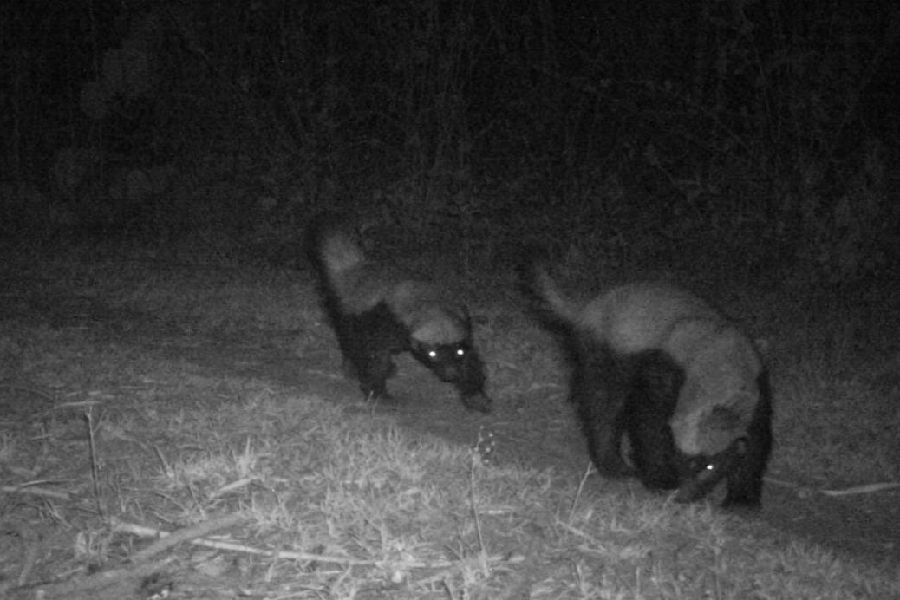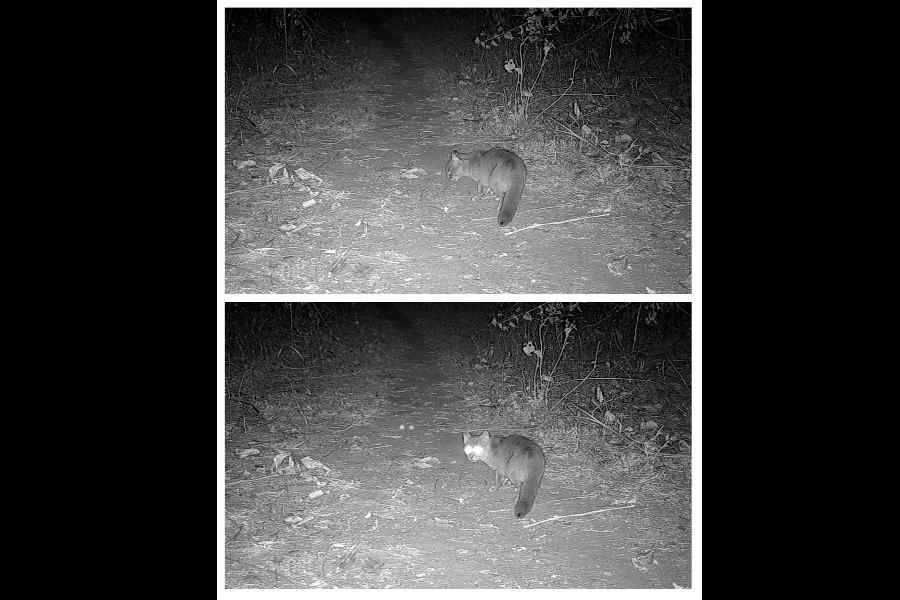Rusty-spotted cat, honey badger, pangolin, hyena, wolf, leopard, black bear.
Purulia, home to all these animals and more, is emerging as a treasure trove of biodiversity in Bengal.
A cat that looks more like a kitten, covered in a fawn coat with rusty brown spots on its back and an unmarked tail, was earlier this month captured by trap cameras in Simni forest of Kotshila range of Purulia.
Wildlife experts and foresters identified the subject as a rusty-spotted cat (Prionailurus rubiginosus), among the world’s smallest cats. It is the first formal documentation of the species in Bengal, they said.
In September last year, cameras had taken pictures of honey badgers (Mellivora capensis) in the same area, also for the first time in Bengal. Honey badger is a tenacious small carnivore with a reputation for being among the world’s most fearless animals and taking on much bigger animals.
In the past five years, the striped hyena (Hyaena hyaena) and Indian wolf (Canis lupus pallipes) have also been captured by trap cameras more than once in Purulia. Wolves and hyenas have been documented in the forests of Jhargram, Bankura and West Burdwan as well.
Dalma elephants have been a recurring presence in the forests of the western districts of Bengal. But barring that, there was nothing much that got the limelight.

Indian grey wolf
“The documentation of these species in the forests of the western districts of Bengal is breaking a stereotype — that Bengal’s rich wildlife is confined to the Sunderbans and north Bengal. Forests like the Sunderbans, Jaldapara and Gorumara hog all the limelight because they are home to the big games like tiger, elephant and the rhinoceros,” said Debal Ray, the chief wildlife warden of Bengal.
Forest officers and wildlife experts said they and the locals were not unaware of the presence of these animals. But the extent of their distribution was largely anecdotal. There has hardly been any scientific documentation of their presence. Now, things are changing.
The forest department has recently done a study on the small mammals in south Bengal. The Sunderbans were not included in the project.
“The findings surprised us. We have recorded a wide variety of small mammals. There has been a huge comeback for animal diversity. The primary reason for this is the development of the quality of forests. Not only the big trees but the ground vegetation has also witnessed great improvement for the past two decades. We are now going for targeted conservation of these small mammals,” Ray said.
Several NGOs working for wildlife conservation have also conducted their own surveys in these forests. The subjects ranged from wolves to hyenas to pangolins.

Striped hyena
Many of these animals have been traced to the forests of Purulia. Ray told this newspaper: “The habitat differentiation makes Purulia special. The forest is not monotonous in Purulia. It has rocky terrains, caves and a lot of variety. They are ideal for thriving micro-ecosystems.”
The latest discovery, the rusty-spotted cat, has been hailed as “significant”.
Dhriti Banerjee, director of the Calcutta-headquartered Zoological Survey of India, said “there is no previous record of the animal in Bengal”.
The cat has so far been recorded from only three countries in the world — India, Sri Lanka and Nepal.
In India, they have earlier been documented in multiple states, including Rajasthan, Maharashtra, Gujarat and Madhya Pradesh.
“Weighing at 0.9 to 1.6 kilograms, this cat is the lightest in the world with a newborn kitten weighing less than a chicken egg,” said Vasudha Mishra from HEAL, the NGO that had set up the cameras for a conservation programme.
The rusty-spotted cat is one of the two smallest cats in the world, the other being the black-footed cat.
With rich biodiversity comes the spectre of conflict because the forests of the western districts of Bengal are interspersed with human settlements.
Hyenas have been butchered in Purulia and West Midnapore before.

Honey badgers
Anjan Guha, the divisional forest officer of Purulia, says the wildlife is thriving with the help of local people.
“The species are flourishing because of congenial habitat. I think Purulia has emerged as a role model in conservation with the help of locals,” he said.
Guha thinks Purulia, already a popular holiday spot, has the potential to emerge as a wildlife tourism hotspot in the future.
“I will send a proposal to the higher authorities, seeking permission for safaris inside the forests,” he said.










